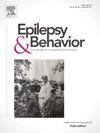Sociodemographic barriers in epilepsy surgery in the United States: A systematic review and meta-analysis
IF 2.3
3区 医学
Q2 BEHAVIORAL SCIENCES
引用次数: 0
Abstract
Objectives
The aim of this study was to perform a systematic review and meta-analysis to identify sociodemographic barriers that could contribute to the underutilization of epilepsy surgery.
Methods
PubMed, EMBASE, and Web of Science databases were systematically reviewed from January 2002 until August 2024. The studies examining the impact of sociodemographic barriers on epilepsy surgery were included. The primary outcomes were the odds ratio (OR) and 95 % confidence intervals (CI) for receiving surgery compared to not-receiving surgery in persons with epilepsy. Race/ethnicity, sex, and insurance had sufficient data to perform a meta-analysis of OR and 95 % CI.
Results
Overall, 1,520,813 patients from 12 studies were evaluated, among which relevant studies were selected for comparing sex (338,170 males and 341,821 females), race (1,056,571 White, 224,693 Hispanic, and 239,549 Black/African-American [Black/AA]), and insurance (232,908 private, 190,849 Medicaid, and 204,478 Medicare). Black/AA patients were significantly less likely to have surgery compared to Whites (OR 0.46, CI 0.35–0.61) or Hispanics (OR: 0.54, CI 0.43–0.67). White patients were more likely to have surgery than other groups examined (OR 1.61, CI 1.28–2.02). There were no significant differences in surgical odds when comparing males to females (OR 1.00, CI 0.97–1.03). Compared to the private insurance, patients with Medicaid (OR 0.61, CI 0.49–0.75) or Medicare (OR: 0.49, CI 0.32–0.77) were less likely to obtain surgery.
Conclusion
This meta-analysis highlights the impact of race/ethnicity, sex, and insurance status in the likelihood of receiving epilepsy surgery and can inform targeted interventions and policies aimed at ensuring equity for disadvantaged groups.
美国癫痫手术的社会人口障碍:一项系统回顾和荟萃分析
目的本研究的目的是进行系统回顾和荟萃分析,以确定可能导致癫痫手术未充分利用的社会人口障碍。方法系统回顾2002年1月至2024年8月spubmed、EMBASE和Web of Science数据库。研究了社会人口障碍对癫痫手术的影响。主要结局是癫痫患者接受手术与未接受手术的比值比(OR)和95%置信区间(CI)。种族/民族、性别和保险有足够的数据进行OR和95% CI的荟萃分析。结果共纳入12项研究的1,520,813例患者,其中选取相关研究进行性别(338,170例男性和341,821例女性)、种族(1,056,571例白人、224,693例西班牙裔和239,549例黑人/非裔美国人[Black/AA])和保险(232,908例私人、190,849例医疗补助和204,478例医疗保险)的比较。与白人(OR: 0.46, CI 0.35-0.61)或西班牙裔(OR: 0.54, CI 0.43-0.67)相比,黑人/AA患者接受手术的可能性显著降低。白人患者比其他组更有可能接受手术(OR 1.61, CI 1.28-2.02)。男性与女性的手术几率无显著差异(OR 1.00, CI 0.97-1.03)。与私人保险相比,医疗补助(OR: 0.61, CI 0.49 - 0.75)或医疗保险(OR: 0.49, CI 0.32-0.77)患者接受手术的可能性较小。结论:该荟萃分析强调了种族/民族、性别和保险状况对接受癫痫手术可能性的影响,可以为有针对性的干预措施和政策提供信息,旨在确保弱势群体的公平。
本文章由计算机程序翻译,如有差异,请以英文原文为准。
求助全文
约1分钟内获得全文
求助全文
来源期刊

Epilepsy & Behavior
医学-行为科学
CiteScore
5.40
自引率
15.40%
发文量
385
审稿时长
43 days
期刊介绍:
Epilepsy & Behavior is the fastest-growing international journal uniquely devoted to the rapid dissemination of the most current information available on the behavioral aspects of seizures and epilepsy.
Epilepsy & Behavior presents original peer-reviewed articles based on laboratory and clinical research. Topics are drawn from a variety of fields, including clinical neurology, neurosurgery, neuropsychiatry, neuropsychology, neurophysiology, neuropharmacology, and neuroimaging.
From September 2012 Epilepsy & Behavior stopped accepting Case Reports for publication in the journal. From this date authors who submit to Epilepsy & Behavior will be offered a transfer or asked to resubmit their Case Reports to its new sister journal, Epilepsy & Behavior Case Reports.
 求助内容:
求助内容: 应助结果提醒方式:
应助结果提醒方式:


